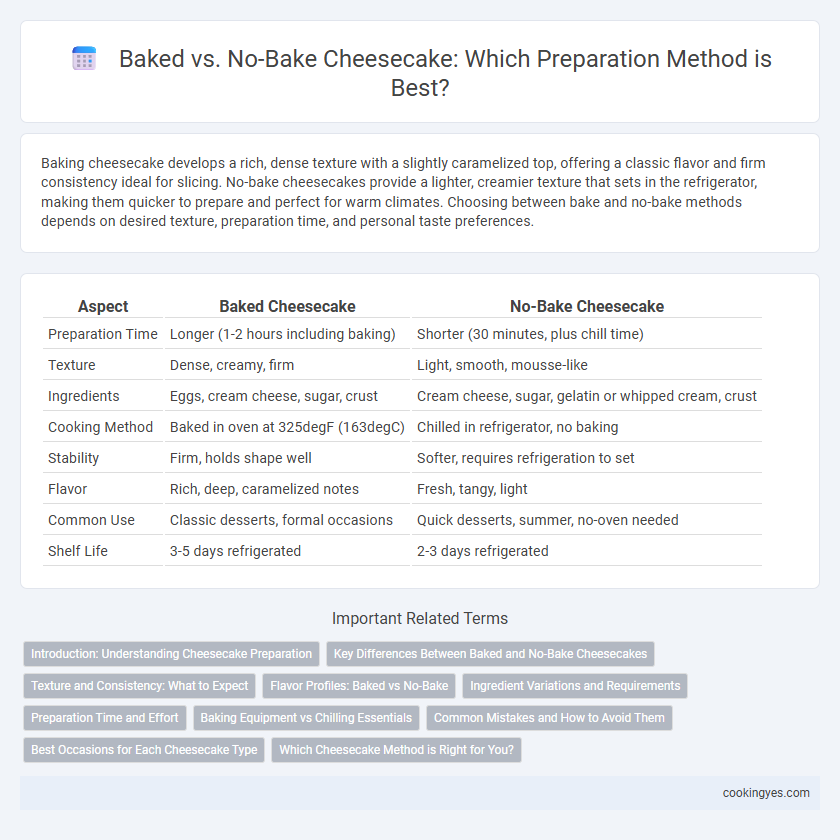Baking cheesecake develops a rich, dense texture with a slightly caramelized top, offering a classic flavor and firm consistency ideal for slicing. No-bake cheesecakes provide a lighter, creamier texture that sets in the refrigerator, making them quicker to prepare and perfect for warm climates. Choosing between bake and no-bake methods depends on desired texture, preparation time, and personal taste preferences.
Table of Comparison
| Aspect | Baked Cheesecake | No-Bake Cheesecake |
|---|---|---|
| Preparation Time | Longer (1-2 hours including baking) | Shorter (30 minutes, plus chill time) |
| Texture | Dense, creamy, firm | Light, smooth, mousse-like |
| Ingredients | Eggs, cream cheese, sugar, crust | Cream cheese, sugar, gelatin or whipped cream, crust |
| Cooking Method | Baked in oven at 325degF (163degC) | Chilled in refrigerator, no baking |
| Stability | Firm, holds shape well | Softer, requires refrigeration to set |
| Flavor | Rich, deep, caramelized notes | Fresh, tangy, light |
| Common Use | Classic desserts, formal occasions | Quick desserts, summer, no-oven needed |
| Shelf Life | 3-5 days refrigerated | 2-3 days refrigerated |
Introduction: Understanding Cheesecake Preparation
Cheesecake preparation varies significantly between baked and no-bake methods, each offering distinct textures and flavors. Baked cheesecakes typically feature a dense, creamy interior achieved through slow oven cooking, while no-bake cheesecakes rely on chilling to set a lighter, mousse-like consistency. Selecting between these methods depends on desired texture, ingredients like cream cheese and gelatin, and preparation time.
Key Differences Between Baked and No-Bake Cheesecakes
Baked cheesecakes achieve a dense, creamy texture through a slow baking process that sets the custard base, often incorporating eggs for structure, while no-bake cheesecakes rely on refrigeration to firm up, resulting in a lighter, mousse-like consistency using gelatin or whipped cream. Baked variants typically require longer preparation time and careful temperature control to prevent cracking, whereas no-bake versions allow for quicker assembly and greater recipe flexibility. Flavor development in baked cheesecakes tends to be richer due to caramelization during baking, contrasting with the fresh, tangy profile of no-bake options that maintain more distinct dairy notes.
Texture and Consistency: What to Expect
Baked cheesecakes have a dense, creamy texture with a firm yet smooth consistency achieved through slow baking and gradual cooling. No-bake cheesecakes offer a lighter, mousse-like texture with a softer, more airy consistency, relying on refrigeration to set the filling. Choosing between bake and no-bake affects the cheesecake's mouthfeel and structural integrity, with baked versions holding shape better when sliced.
Flavor Profiles: Baked vs No-Bake
Baked cheesecakes develop a rich, dense texture with a caramelized, slightly toasted flavor due to the Maillard reaction during baking. No-bake cheesecakes offer a lighter, creamier consistency with a fresh, tangy taste, as they rely on chilling rather than heat to set. The flavor profile in baked versions emphasizes depth and intensity, while no-bake varieties highlight smoothness and bright cream cheese notes.
Ingredient Variations and Requirements
Baked cheesecakes require ingredients like eggs for structure and stability, while no-bake versions rely more on gelatin or cream cheese to set properly. The ingredient proportions differ significantly; baked recipes demand precise oven temperatures to achieve a dense, creamy texture, whereas no-bake variations depend on refrigeration time for firmness. Sugar and cream cheese quality impact both types, but the presence of eggs and baking powder is unique to baked cheesecakes, influencing their flavor and mouthfeel.
Preparation Time and Effort
Bake cheesecakes require longer preparation time, typically around 1 to 1.5 hours including baking and cooling, demanding more precise temperature control and patience. No-bake cheesecakes are quicker, often ready within 4 hours including chilling, with simpler preparation steps and less technical skill needed. Choosing between them depends on available time and desired texture, as baked versions offer a denser consistency while no-bake ones remain creamy and light.
Baking Equipment vs Chilling Essentials
Baking equipment such as springform pans, oven thermometers, and water bath setups are essential for achieving the perfect texture and crust in traditional baked cheesecakes. No-bake cheesecakes rely heavily on chilling essentials like refrigeration, airtight containers, and gelatin or cream cheese stabilizers to set the dessert firmly without heat. Choosing between baking and chilling methods depends on equipment availability and desired cheesecake consistency.
Common Mistakes and How to Avoid Them
Common mistakes in baked cheesecake preparation include overbaking, which causes cracks, and underbaking, resulting in a runny center; to avoid this, bake at a consistent low temperature and use a water bath for even heat distribution. No-bake cheesecakes often suffer from inadequate chilling time, leading to a soft texture; ensure refrigeration for at least 4 hours or overnight to achieve the right firmness. Using room temperature ingredients in both methods prevents texture issues and promotes smooth, creamy consistency.
Best Occasions for Each Cheesecake Type
Baked cheesecakes, with their rich, dense texture, are ideal for formal occasions such as dinner parties and holiday gatherings, where a classic dessert presentation is desired. No-bake cheesecakes offer a lighter, creamier alternative perfect for casual summer events, picnics, or when time constraints require a quick and easy preparation. Choosing between bake and no-bake cheesecakes depends on the desired texture, flavor depth, and the event's formality, ensuring the dessert complements the occasion seamlessly.
Which Cheesecake Method is Right for You?
Baked cheesecakes offer a denser, creamier texture due to the cooking process that firms the cream cheese and eggs, ideal for those seeking a traditional, rich dessert. No-bake cheesecakes provide a lighter, mousse-like consistency with a quicker preparation time, perfect for beginners or warm climates where refrigeration is preferred over oven use. Choosing between baked and no-bake cheesecake depends on texture preference, available preparation time, and dessert setting requirements.
Bake vs No-Bake for Cheesecake Preparation Infographic

 cookingyes.com
cookingyes.com